Die Frist für die Einschreibung in Übungsgruppen ist verstrichen. Vielen Dank für Ihre Teilnahme.
Falls Sie sich nicht eingeschrieben haben, und dennoch an einer Übung teilnehmen möchten, schreiben Sie mir bitte eine Email. Ich teile Sie dann einer Gruppe zu, in der noch Platz ist.
Our group is elucidating with multi-scale simulations how phase separation can provide for specific regulation in biology and how dysregulation of phase separation can lead to disease.
Our group has joined the collaborative research project TRR146 Multiscale Simulation Methods for Soft-Matter Systems for its third funding period with a joint project with Thomas Speck.
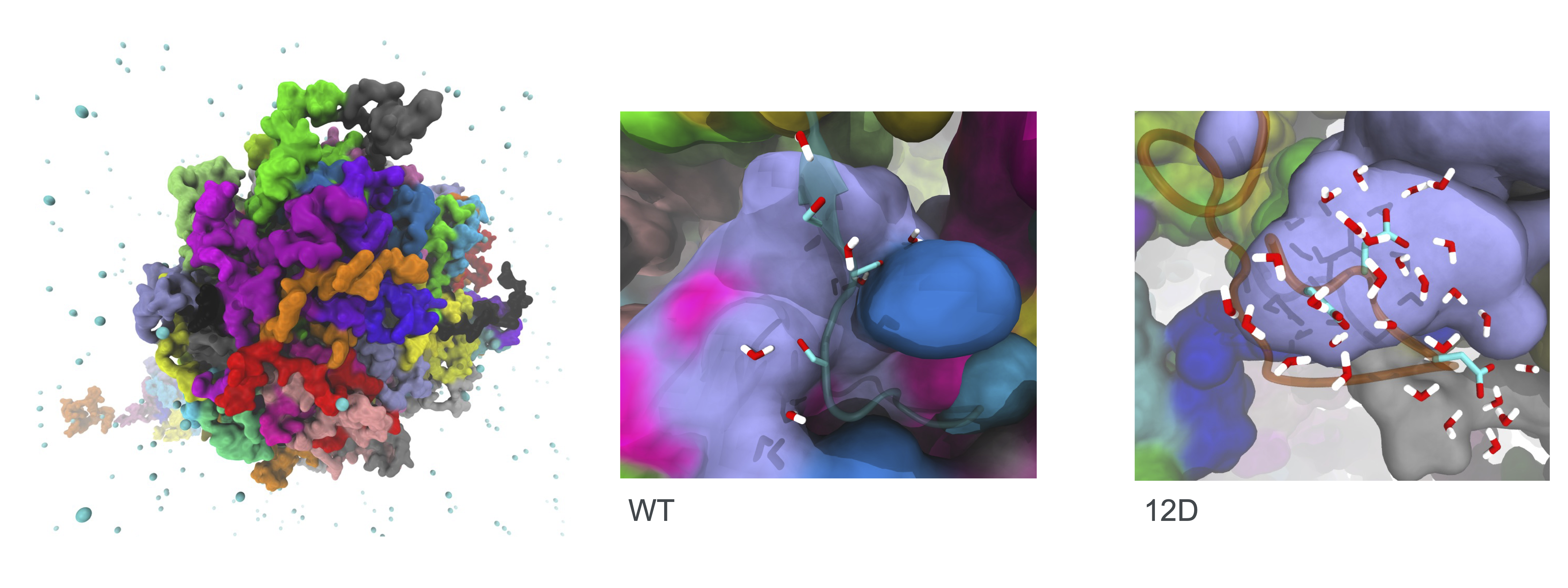
Multi-scale simulations of TDP-43. Left: Phase-separated condensate of the disordered domain of TDP-43 from coarse-grained simulation. Centre: Details of water-binding to sites to serines residues in C-terminus of the disordered domain from atomistic simulations of a TDP-43 condensate. Right: Atomistic simulation of phosphomicking 12D mutant shows more water molecules are bound at sites of phosphomimcking mutations compared to wild-type TDP-43. Figure adapted from Grujis da Silva et al EMBO J, 2022
A seminar course on Soft Matter and Biological Physics is offered in the summer term 2019.
Time: Tuesday 14:00-16:00
Place: Newton Raum (01-122)
This course is open to master students (as Master Seminar I or II). Bachelor students with knowledge in statistical physics (Theory 4) are also welcome to attend.
Soft matter is an interdisciplinary field, which combines aspects from physics, chemistry and biology. The range of topics where physicists can contribute is broad and steadily growing. Examples include
- Mechanics and thermodynamics of (bio)polymers
- Biomaterials (membranes, bones, cartilage)
- Physics of microswimmers and active particles
- Microfluidic devices for particle sorting and separation
The purpose of this course is to introduce students into this fascinating field. We will not be able cover all aspects of soft matter, but instead focus on selected topics (see list below). The seminar will provide physical background and present applications in soft matter physics.
Critical reading, analysis and discussion of scientific literature is one of the key aspects of modern science, and therefore we will practice these skills during the first 4 sessions of this seminar course. In particular, we will interactively develop and practice the following work strategies:
- Summarizing articles
- Providing constructive feedback
- Planning and preparing presentations
The scientific part of the seminar is organized as follows:
- Every student is supposed to give an approximately 30 minutes long talk on the selected topic
- Please pick your topic before the beginning of the course by sending an e-mail to Sara Jabbari Farouji and Arash Nikoubashman
- Contact your talk supervisor at least 4 weeks prior to your presentation for material
- Prepare a first version at least 2 weeks before the presentation
- Schedule a practice talk with your supervisor for the week before the presentation
- Upload your presentation to the seafile folder to share it with your colleagues
Literature
Literature will be provided by your talk supervisor.
List of topics
Vorlesung: Freitag 8:00-11:00, HS Kph
Übungen:
Oberassistent: Pascal Wasser (email)
Abgabe rote Kästen Staudingerweg 7 (38: 1+2, 39: 9+4, 40: 5+6, 41: 7+8)
- Gruppe: Mittwoch 12:00-14:00 Uhr (Seminarraum E) Maike Jung
- Gruppe: Mittwoch 12:00-14:00 Uhr (Seminarraum F) Zeki Aydin
- Gruppe: Mittwoch 14:00-16:00 Uhr (Seminarraum A) Annika Stein
- Gruppe: Mittwoch 16:00-18:00 Uhr (Seminarraum F) Andreas Fischer
- Gruppe: Freitag 12:00-14:00 Uhr (Newtonraum) Ardit Krasniqi
- Gruppe: Freitag 12:00-14:00 Uhr (Seminarraum D) Dennis Layh
- Gruppe: Freitag 12:00-14:00 Uhr (Seminarraum F) Niklas Pfeifer
Übungsblätter
Für die Klausurzulassung müssen 50% der Aufgaben bearbeitet, 50% der Punkte erreicht und einmal vorgerechnet werden.
Übungsblätter erscheinen online im JGU reader. Zugang über Uni-Account für alle über Jogustine angemeldeten Teilnehmer der Vorlesung.
Literatur und Material
Skripte:
Online:
Bücher:
- P. van Dongen, Einführungskurs Mathematik und Rechenmethoden
- W. Nolting, Theoretische Physik Bd. 1 (erstes Kapitel)
- S. Großmann, Mathematischer Einführungskurs für die Physik
- K.-H. Goldhorn und H.-P. Heinz, Mathematik für Physiker 1
- C. Lang und N. Pucker, Mathematische Methoden in der Physik
- M.L. Boas, Mathematical Methods in the Physical Sciences
- und viele mehr
A seminar/lecture course on Biological Physics was offered in the summer term 2018.
Time: Thursday 2pm - 4pm
Place: Galilei-room (Staudingerweg 9, First floor)
It is open to master students (as Master Seminar I or II). Bachelor students with knowledge in statistical physics (Theory 4) are also welcome to attend.
Biological physics is an interdisciplinary field where methods and tools from physics are applied to problems in biology. The range of topics where physicists can contribute is broad and steadily growing. Examples are
- Mechanics and thermodynamics of proteins
- Biomaterials (membranes, bones, cartilage)
- Cell mechanics and thermodynamics of cellular processes
- Bioimaging and high resolution microscopy
- Physics of living tissues (including: physics of cancer)
- Biological networks
- Neuroscience
- Evolution
The purpose of the course is to introduce students into this fascinating field. We will not be able cover everything, but instead focus on selected aspects depending on the interests of the participants. The lectures will provide physical background (e.g., phase transitions, polymer physics, stochastic processes), and the seminar talks will present applications in biological physics. The topics of the talks are assigned to the students on April 19th.
Literature
- Biophysics, R. Glaser, Springer (available in the PMC library)
- Physics of Life, IFF spring school 2018 Lecture Notes, available online here.
- Biophysics: Searching for principles, W. Bialek, Princeton Univ. Press, preprint available here.
- Molecular Biology of the Cell B. Alberts, A. Johnson, J. Lewis, D. Morgan, M. Raff, K. Roberts, Garland Science Publications (provides biology background, available in the PMC library)
Further literature and the slides of the presentations will be made available to participants here. Please log in with your ZDV credentials.
List of topics
Date/Contact
|
Topic
|
Literature
(for example) |
| 19.4, 26.4, 3.5. |
Introductory lectures: Some physics background |
|
| 17. 5. |
Methods: Experimental (superresolution microscopy, scattering) |
[2] A1-A3 or A4,A5 |
| G. Settanni |
Methods: Simulations (biomolecular simulations)
|
[2] A9, A10 |
| 24. 5. |
Molecules - DNA: Sequence and alignment |
tba |
| P. Virnau |
Molecules - DNA: Molecular organization and chromatin |
[2] B5 |
| 1. 6. |
Molecules - Proteins: Structure and crystallography |
[2] A4, A5 |
| F. Schmid |
Molecules - Proteins: protein folding |
[3] Chap. III.A |
| 7. 6. |
Cell components: Membranes |
[2] C1 |
| F. Schmid |
Cell components: Cytoskeleton |
[2] C3, C6 |
| 14. 6. |
Cellular organization: Cell states and Turing patterns |
[3] Chap III.C, |
| P. Virnau |
Cellular organization: Tissue growth
|
[2] E6 |
| 21. 6. |
Neurons: Ion channels and neuronal dynamics |
[3] Chapter III.B |
| F. Schmid |
Neurons: Neural networks |
[3] Chapter III.D |
| 28. 6. |
Transport: Hydrodynamics in biology |
[1] Chap 3.7 |
| T. Speck |
Transport: Motility of cells and bacteria |
[3(final)] Chap 4.2 |
| 5. 7. |
Evolution |
[2] F2, F7 |
| F. Schmid |
Systems theory |
[1] Ch. 5, [3] Ch. IV |

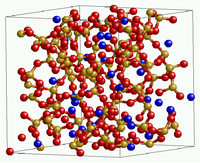 Understanding what causes the transition from undercooled fluids to glasses is one of the grand challenge problems of condensed matter physics, and for many years has been one of the main research topics of the Condensed Matter Theory Group at Mainz, and much of this research even has been condensed in a textbook (K. Binder and W. Kob, Glassy Materials and Disordered Solids: An Introduction to their Statistical Mechanics, 2nd ed., World Scientific, Singapore, 2010). Our recent work on this topic has focused on the analysis of the dynamics of probe molecules inserted as "reporters" into a glassforming matrix, a problem relevant to the analysis of single molecule spectroscopy experiments. This research is done in collaboration with R. Vallee (University of Bordeaux), W. Kob (University of Montpellier II), and W. Paul (Univ. Halle). For more information, please contact Kurt Binder.
Understanding what causes the transition from undercooled fluids to glasses is one of the grand challenge problems of condensed matter physics, and for many years has been one of the main research topics of the Condensed Matter Theory Group at Mainz, and much of this research even has been condensed in a textbook (K. Binder and W. Kob, Glassy Materials and Disordered Solids: An Introduction to their Statistical Mechanics, 2nd ed., World Scientific, Singapore, 2010). Our recent work on this topic has focused on the analysis of the dynamics of probe molecules inserted as "reporters" into a glassforming matrix, a problem relevant to the analysis of single molecule spectroscopy experiments. This research is done in collaboration with R. Vallee (University of Bordeaux), W. Kob (University of Montpellier II), and W. Paul (Univ. Halle). For more information, please contact Kurt Binder.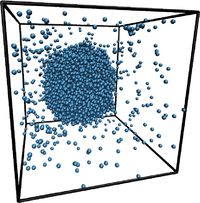 Metastable phases decay by rare statistical fluctuations, termed "nucleation", where a "critical cluster" (i.e., a nanoscopic aggregate of the new phase having the minimal size to be able to grow) forms. Such critical clusters may form in the bulk ("homogeneous nucleation"), which facilitate this cluster formation by reducing the free energy barrier that needs to be overcome. Specialized computer simulation methods are developed to estimate the surface excess free energies, that control these processes, and related quantities (such as contact angles, line tension, Tolman length). This research is carried out in the framework of the priority program SPP 1296 "Heterogeneous Nucleation and Structure Formation" of the German Research Foundation (DFG), and we collaborate with J. Horbach (DLR Cologne) and S. Egelhaaf and H. Löwen (University of Düsseldorf), where complementary studies are done, as well as with S. K. Das (Bangalore) and S. Puri (New Delhi, India). For more information, please contact
Metastable phases decay by rare statistical fluctuations, termed "nucleation", where a "critical cluster" (i.e., a nanoscopic aggregate of the new phase having the minimal size to be able to grow) forms. Such critical clusters may form in the bulk ("homogeneous nucleation"), which facilitate this cluster formation by reducing the free energy barrier that needs to be overcome. Specialized computer simulation methods are developed to estimate the surface excess free energies, that control these processes, and related quantities (such as contact angles, line tension, Tolman length). This research is carried out in the framework of the priority program SPP 1296 "Heterogeneous Nucleation and Structure Formation" of the German Research Foundation (DFG), and we collaborate with J. Horbach (DLR Cologne) and S. Egelhaaf and H. Löwen (University of Düsseldorf), where complementary studies are done, as well as with S. K. Das (Bangalore) and S. Puri (New Delhi, India). For more information, please contact 
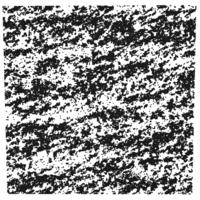
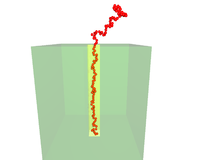
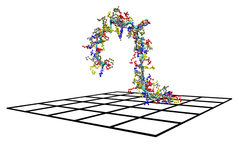
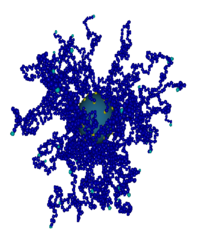
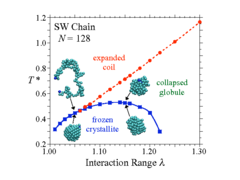 A single polymer chain in a poor solvent may collapse into a dense fluid globule, but it may instead also crystallize: By extensive simulations with the Wang-Landau algorithm we have shown that the crystal is favorable if the range of the attractive interactions between the monomers exceeds the range of the repulsions only slightly. These findings may be useful to understand scenarios for protein crystallization. The resulting structure is also modified when an attractive substrate surface is present, and/or when one considers a semiflexible rather than a flexible polymer: then liquid-crystal-line ordering comes into play. Single chains then may collapse forming torodial or plate-like strucutures, or lamellae attached to walls. Multichain systems, or semi-flexible polymers, however, are found to undergo isotropic to nematic transitions, similar to systems of hard rods. In the presence of confinement into thin films by hard walls, "capillary normalization" (i.e. wall-induced nematic order) is found. This research is carried out in collaboration with V. A. Ivanov (Moscow State University), J. Luettmer-Strathmann (The University of Akron), M. P. Taylor (Hiram College), and W. Paul (Martin Luther Universität Halle.) For more Information, please contact
A single polymer chain in a poor solvent may collapse into a dense fluid globule, but it may instead also crystallize: By extensive simulations with the Wang-Landau algorithm we have shown that the crystal is favorable if the range of the attractive interactions between the monomers exceeds the range of the repulsions only slightly. These findings may be useful to understand scenarios for protein crystallization. The resulting structure is also modified when an attractive substrate surface is present, and/or when one considers a semiflexible rather than a flexible polymer: then liquid-crystal-line ordering comes into play. Single chains then may collapse forming torodial or plate-like strucutures, or lamellae attached to walls. Multichain systems, or semi-flexible polymers, however, are found to undergo isotropic to nematic transitions, similar to systems of hard rods. In the presence of confinement into thin films by hard walls, "capillary normalization" (i.e. wall-induced nematic order) is found. This research is carried out in collaboration with V. A. Ivanov (Moscow State University), J. Luettmer-Strathmann (The University of Akron), M. P. Taylor (Hiram College), and W. Paul (Martin Luther Universität Halle.) For more Information, please contact 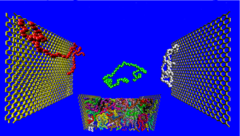
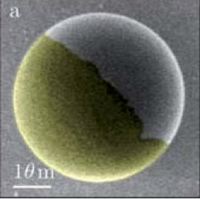 Dynamical collective behavior observed in, e.g., schools of fish and flocks of birds can often be described with simple models of so-called self-propelled particles. Even complex behavior can be reproduced by simple rules that are followed by all individuals (e.g., follow your neighbors but do not bump into them). On the microscale, both bacteria and colloidal particles have emerged as model systems to study a wealth of different phenomena such as swirling, swarming, and turbulence.
Dynamical collective behavior observed in, e.g., schools of fish and flocks of birds can often be described with simple models of so-called self-propelled particles. Even complex behavior can be reproduced by simple rules that are followed by all individuals (e.g., follow your neighbors but do not bump into them). On the microscale, both bacteria and colloidal particles have emerged as model systems to study a wealth of different phenomena such as swirling, swarming, and turbulence. 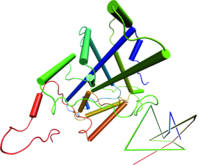 Although globular homopolymers are typically highly knotted, less than one in a hundred protein structures contain a knot ( http://knots.mit.edu ). Nevertheless, intriguing counter-examples exist, like the most complicated protein knot, which was discovered recently during a diploma thesis in our group (see figure on the left). Apart from analyzing biological data, we perform Monte Carlo simulations of simplified protein and DNA models to learn more about entanglements in viral DNA, chromatin and proteins. On this topic, we collaborate with theory groups at MIT and an experimental group at the MPI for Polymer Research. If you are interested in interdisciplinary investigations at the frontier of physics, mathematics and molecular biology, please contact
Although globular homopolymers are typically highly knotted, less than one in a hundred protein structures contain a knot ( http://knots.mit.edu ). Nevertheless, intriguing counter-examples exist, like the most complicated protein knot, which was discovered recently during a diploma thesis in our group (see figure on the left). Apart from analyzing biological data, we perform Monte Carlo simulations of simplified protein and DNA models to learn more about entanglements in viral DNA, chromatin and proteins. On this topic, we collaborate with theory groups at MIT and an experimental group at the MPI for Polymer Research. If you are interested in interdisciplinary investigations at the frontier of physics, mathematics and molecular biology, please contact